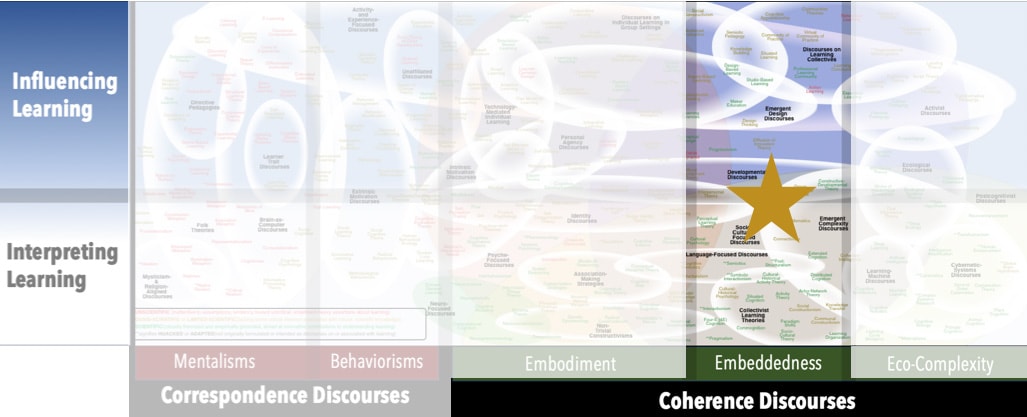Focus
Transformations and qualities of task-focused teamsPrincipal Metaphors
- Knowledge is … scope of possible collective actions
- Knowing is … on-task activity
- Learner is … a team
- Learning is … stepped progress toward task completion
- Teaching is … N/A
Originated
1940sSynopsis
As might be inferred from the name, Group Development Theories comprise a host of models and perspectives intended to interpret the evolution of task-oriented collectives. Prominent foci of the many different theories include sequences of development-based stages, clusters of purpose-based phrases, typologies of conflict-focused dynamics, and cycles of evolutionary transformation. The partial list presented below illustrates similarities and differences of prominent Group Development Theories (listed chronologically, by decade):- Lewin's Model of Change (Lewin’s Change Management Model; 3-Step Change Management Model) (Kurt Lewin, 1950s) – a model that posits organizational change as a three-step process: Unfreeze (identifcation of an issue, analysis, proposal, initial community engagement), Change (implementation and continuing communication); Refreeze (implementation of structures to maintain new practices, accompanied by a critical view of the process and attainment.
- Tuckman’s Model of Group Development (Bruce Tuckman, 1960s) – five-stage (forming, storming, norming, performing, adjourning) linear model
- Fisher’s Theory of Decision Emergence in Groups (B. Aubrey Fisher, 1970s) – four phases (orientation, conflict, emergence, reinforcement) of decision making by task groups
- Gersick’s Punctuated Equilibrium Model (Connie Gersick, 1980s) – model of three “frameworks for performance” (sudden formation, maintenance, sudden revision) to describe the development of naturally occurring groups. (The model is based on the notion of Punctuated Equilibrium; see Universal Darwinism.)
- Poole’s Multiple-Sequence Model (Marshall Scott Poole, 1980s) – model of three “activity tracks” (task, relation, topic) to interpret different groups’ approaches to making decisions
- Hackman’s Multilevel Perspective (Richard Hackman, 1980s) – model of group behavior based on three levels of analysis (micro/individual, meso/group, macro/organizational or societal)
- McGrath’s Time, Interaction, and Performance Theory (J.E. MaGrath, 1990s) – four modes of group activity (inception, technical problem solving, conflict resolution, execution) to describe different developmental paths used by different teams to reach the same goal
- TEAM Model (B.B. Morgan Jr., E. Salas, Bruce Tuckman, 1990s) – nine-stage (pre-forming, forming, storming, norming, performing-I, reforming, performing-II, conforming, de-forming) developmental model to describe the evolution of new, task-oriented teams
- Tubb’s Systems Model (Stewart Tubbs, 1990s) – four-phase (orientation, conflict, consensus, closure) model of small-group interaction
- Wheelan’s Integrated Model of Group Development (Susan Wheelan, 1990s) – a five-stage (dependency & inclusion, counterdependency & fight, trust/structure, work/productivity, termination) unified model of group development
- Interthinking (Neil Mercer, 2010s) – collective thinking through discussion (oral language)
Commentary
Most Group Development Theories were developed (or based on precursors that were developed) prior to the popularization of Socio-Cultural Theory and other Embeddedness Discourses. Consequently, they tend to be articulated in terms of uncritical and unsophisticated sum-of-the-parts mechanics rather than more-than-the-sum-of-the-parts dynamics. (There are occasional exceptions.) Their general lack of theoretical sophistication might also help to explain why most offer little more than snapshots of particular groups at specific points in development.Authors and/or Prominent Influences
DiffuseStatus as a Theory of Learning
Group Development Theories can be construed as theories concerned with how groups learn – that is, how they change and adapt as they work their ways to predefined endpoints.Status as a Theory of Teaching
For the most part, Group Development Theories are descriptions that are based on specific cases – and so they have little to offer by way of generalizable advice. That is, broadly speaking, Group Development Theories are not theories are teaching.Status as a Scientific Theory
Most Group Development Theories are founded on case-based descriptive accounts, with limited generalizability. In addition, few involve interrogations of assumptions or metaphors. Consequently, broadly speaking, Group Development Theories do not meet our criteria for scientific theories.Subdiscourses:
- Fisher’s Theory of Decision Emergence
- Gersick’s Punctuated Equilibrium Model
- Hackman’s Multilevel Perspective
- Interthinking
- McGrath’s Time, Interaction, and Performance Theory
- Poole’s Multiple-Sequence Model
- TEAM Model
- Tubb’s Systems Model
- Tuckman’s Model of Group Development
- Wheelan’s Integrated Model of Group Development
- Lewin’s Model of Change (Lewin’s Change Management Model; 3-Step Change Management Model)
Map Location

Please cite this article as:
Davis, B., & Francis, K. (2023). “Group Development Theories” in Discourses on Learning in Education. https://learningdiscourses.com.
⇦ Back to Map
⇦ Back to List
